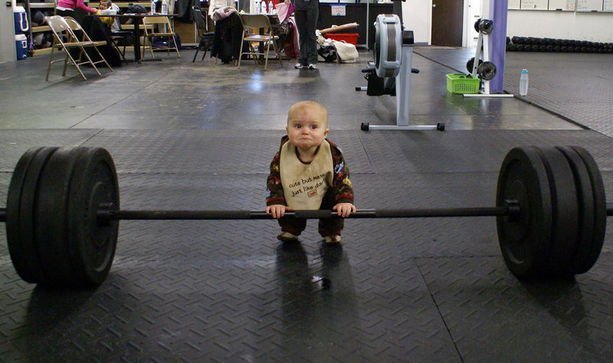> Your stomach will explode if you eat Pop-Rocks and drink Coca-Cola MYTH
> Bigfoot MYTH
> Alligators living in Manhattan sewers MYTH
> Weight training will stunt a child’s growth MYTH
“There is no minimal age requirement for participation, although children must be able to follow directions and demonstrate adequate balance and proprioception which generally occurs by 7 or 8 years of age…” -Katherine Stabenow Dahab, MD* and Teri Metcalf McCambridge, MD, FAAP
Amazingly the weight training myth lives on in the hearts and minds of helicopter parents. Today however, virtually every medical, coaching, and training professional and organization in the country approve (and endorse) weight training for kids, provided that explicit instruction is given and certain guidelines are adhered to. Even the ever cautious American College of Sports Medicine promotes it in athletes as young as elementary school. We beg that people use common sense (another scarcity in society today) while digesting this. We are not talking about power lifting, dead lifting, or 1 rep maxes. We are not talking about pyramid sets, descending sets, negative reps, and 2 hour gym work-outs for kids. And for those of you inspired by our humor ready to put your kid in diapers under a barbell; sorry to disappoint you but we are also not talking about toddlers and babies weight training — no good.
“Will my child stunt their growth if he/she lifts weights?”
(Dr. Daniel G. Drury) The answer to this question is “NO” plain and simple. In the
past, people thought that if a child lifted something heavy (barbells or dumbbells) the gravitational pressure would damage the soft growth plates on the end of their bones. The bones would then heal and fuse pre-maturely leading to a stunted growth. This simply isn’t true. Children should avoid maximal lifts (powerlifting), but avoiding ALL forms of strength training as a rule is just counterproductive.
You see, physiologically your muscles don’t know the differences between the resistance provided by strength training or the resistance provided by vigorous work or play. A muscle will contract and create force to counter any type of resistance. If the resistance is introduced safely, on a regular basis and at the right intensity, the muscle will respond by getting stronger.
If this strength training myth were true, children all over the world would be suffering from this horrible condition. Kids that complete heavy chores on the family farm would be tiny. Kids that play explosive youth sports would just stop growing and we would have strict rules about running too fast, giving piggy back rides and wheel barrel races. All of these activities require heavy muscular effort, but DO NOT STUNT GROWTH. As a matter of fact, kids in elementary school can safely and effectively lift weights to promote health and build strength. Yes, it’s downright good for them! The key thing for parents to understand is that a child must be mature enough to follow safe lifting guidelines and dedicated enough to follow a well-designed regimented program. In other words, the age at which a child can begin strength training is determined more by the child’s maturity versus their chronological age. Supervision and guidance are also very important factors as the child learns this new skill.
“Despite the previously held contention that children would not benefit from strength training due to insufficient levels of circulating androgens, research conducted over the past decade clearly demonstrates that regular participation in a youth strength training program can offer observable health and fitness value to boys and girls.” -American College of Sports Medicine
A light weight training program with single or double sets and reps in the 10-15 range can benefit every young child. Contrary to the obsolete myths of the past; weight training can actually promote growth in children, not hinder it. Numerous studies and professionals have concluded that weight training can strengthen bones in children, increase neurological efficiency, promote confidence, and have a range of other benefits.
More from the American College of Sports Medicine:
Myth: Strength training is unsafe for children.
Fact: The risks associated with strength training are not greater than other sports and activities in which children regularly participate. However, the key is to provide qualified supervision, age-specific instruction and a safe training environment because, as in many sports, accidents can happen if children do not follow established training guidelines. Children should not use strength training equipment at home without supervision from a qualified professional.
Myth: Strength training will stunt the growth of children.
Fact: There is no current evidence to indicate a decrease in stature in children who regularly strength train in a supervised environment with qualified instruction. In all likelihood, participation in weight-bearing physical activities (including strength training) will have a favorable influence on growth at any stage of development but will not affect a child’s genetic height potential.
Myth: Children will experience bone growth plate damage as a result of strength training.
Fact: A growth plate fracture has not been reported in any research study that was competently supervised and appropriately designed. Nonetheless, youth coaches, physical education teachers and fitness instructors must be aware of the inherent risk associated with strength training and should attempt to decrease this risk by following established training guidelines.
Myth: Children cannot increase strength because they do not have enough testosterone.
Fact: Testosterone is not essential for achieving strength gains, as evidenced by women and elderly individuals who experience impressive gains in strength even though they have little testosterone. When compared on a relative or percent basis, training-induced strength gains in children are comparable to those in adolescents and adults.
Myth: Strength training is only for young athletes.
Fact: While regular participation in a strength training program can enhance the performance of young athletes and reduce their risk of sports-related injuries, boys and girls of all abilities can benefit from strength training. For example, strength training can enhance the bone mineral density of girls, decreasing their risk of developing osteoporosis, and can spark an interest in physical activity in overweight children who tend to dislike prolonged periods of aerobic exercise. Due to individual differences in fitness experience and training goals, an advanced strength training program for a young athlete would be inappropriate for an inactive child who should be given an opportunity to learn proper exercise technique and experience the mere enjoyment of strength exercise.
The belief that strength training is unsafe for children is not consistent with the needs of boys and girls and the documented risks associated with this type of training. However, strength training is a specialized method of conditioning that requires qualified supervision, appropriate overload, gradual progression, and adequate recovery between exercise sessions. Furthermore, when designing youth strength training programs it is important to remember that the goal of the program should not be limited to increasing muscle strength. Teaching youth about their bodies, promoting safe training procedures, and providing a stimulating program that gives participants a more positive attitude toward strength training and physical activity in general are equally important.
More:
Strength Training in Children
Raising the Bar for Young Athletes
Katherine Stabenow Dahab, MD* and Teri Metcalf McCambridge, MD, FAAP
Abstract
Context:
Strength training in children, in combination with plyometric and/or agility training, has become an increasingly popular tactic for athletes to gain a competitive edge during the off-season. The present review clarifies some common myths associated with strength training in children, and it outlines the most current recommendations.
Evidence Acquisition:
Relevant studies on strength training in children and adolescents were reviewed (search results included studies indexed in PubMed and MEDLINE from 1980 through 2008). Also reviewed were recommendations from consensus guidelines and position statements applicable to strength training in youth.
Results:
Children can improve strength by 30% to 50% after just 8 to 12 weeks of a well-designed strength training program. Youth need to continue to train at least 2 times per week to maintain strength. The case reports of injuries related to strength training, including epiphyseal plate fractures and lower back injuries, are primarily attributed to the misuse of equipment, inappropriate weight, improper technique, or lack of qualified adult supervision.
Conclusion:
“Youth—athletes and nonathletes alike—can successfully and safely improve their strength and overall health by participating in a well-supervised program. Trained fitness professionals play an essential role in ensuring proper technique, form, progression of exercises, and safety in this age group.”
Competitive athletes and nonathletes alike may be interested in strength training for various reasons, including their athletic prowess and physique. Interested in off-season conditioning, parents and preadolescent athletes often turn their attention to strength training.
“These programs can benefit many children and preadolescents by improving not only their strength but also their bone density, balance, lipid profiles, fat-free mass, and personal self-esteem.”
12,18,20,38,45 Recent studies have focused on the benefits of strength training for children with cerebral palsy, thereby demonstrating improved daily function and self-esteem.29,43
Exercise and sports are an important part of childhood. The lessons learned from team and individual sports are applicable throughout life. Children who establish regular exercise habits will ideally continue them into adulthood. The Centers for Disease Control and Prevention and the American Academy of Pediatrics recommend that all school-aged children participate in at least 60 minutes of moderate to vigorous developmentally appropriate physical activity each day.
The primary concerns regarding strength training are safety and its effectiveness.
“Health care and fitness professional groups—including the American Academy of Pediatrics, the American College of Sports Medicine, the American Orthopedic Society for Sports Medicine, and the National Strength and Conditioning Association—agree that a supervised strength training program that follows the recommended guidelines and precautions is safe and effective for children.”1,3,9,14,39
This review study sought to evaluate applicable articles and consensus statements regarding strength training in young athletes. Search results included studies indexed in PubMed and MEDLINE from 1980 through 2008. Also reviewed were consensus guidelines, position statements, and recommendations concerning strength training in youth from the American Academy of Pediatrics, the American College of Sports Medicine, the American Orthopedic Society for Sports Medicine, and the National Strength and Conditioning Association.1-3,10,15,39
Participation Requirements
A child’s physical, cognitive, and social maturity are key factors in determining the age at which a child is ready to participate in a strength training program.
“There is no minimal age requirement for participation, although children must be able to follow directions and demonstrate adequate balance and proprioception.”
Before starting a program, children should have a preparticipation physical exam by a qualified medical professional. The screening exam is necessary because some children should not participate due to medical reasons.
The American Academy of Pediatrics recommends that children and adolescents with cardiomyopathy (especially, hypertrophic cardiomyopathy) should not strength train.1 They are at risk for worsening ventricular hypertrophy and restrictive cardiomyopathy or hemodynamic decompensation due to acute increases in pulmonary hypertension with resistance training. Children with isolated pulmonary hypertension should not participate in these programs either. Those with stage 2 hypertension or end-organ damage from hypertension require medical clearance before participation, owing to the risk for increased elevation of blood pressure while training.36 Chemotherapy with anthracyclines, which are cardiotoxic, may also preclude strength training. Doxorubicin, daunomycin/daunorubicin, idarubicin, and possibly mitoxantrone have been linked to acute congestive heart failure. Marfan syndrome patients with a dilated aortic root4 should not participate, whereas those children with seizure disorders need to demonstrate good seizure control before participation in these programs.
Guidelines for Strength Training
Before a child starts a training program, the training supervisor, the child, and the parents should discuss the goals and expectations. The dangers of anabolic steroids and other performance-enhancing substances should be part of that discussion. Current studies report that the rate of anabolic steroid use in adolescents ranges from 1.5% to 7.6%.42 Youth should be counseled about the risks and health consequences of steroid use and be strongly discouraged from using such substances.
Weight training programs should be individualized on the basis of age, maturity, and personal goals and objectives. Each training session should include a 5- to 10-minute warm-up and a 5- to 10-minute cooldown. Warm-up activities help to increase body temperature and blood flow (ie, to the musculature), whereas cooldown activities help to maintain blood flow to enhance recovery and flexibility. Programs that incorporate an aerobic component are most beneficial because they improve overall cardiovascular fitness and stimulate an increase in metabolism.
When a child or adolescent is learning a new exercise, he or she can use no-load repetitions, which places the focus on form and technique. To properly develop strength and promote flexibility, exercises should be performed through the full range of joint motion,7,14,44 performing larger-muscle exercises before smaller-muscle exercises. Furthermore, complex exercises are generally done before simple exercises, and multijoint exercises, before single-joint ones. In summary, starting big and ending small is a good guideline for training.
In general, children and adolescents should use submaximal loads to develop form and technique in a variety of exercises. The American Academy of Pediatrics does not endorse using continuous maximal lifts for youth strength training.1 Single maximal lifts are not recommended until skeletal maturity is attained,1 even though studies of single-repetition testing reported no injuries in healthy children with proper supervision on child-sized weight training machines.16
Youth strength training programs should ideally incorporate a variety of resistance types: free weights, weight machines, rubber tubing, and medicine balls. Free weights and weight machines pose unique challenges for children and adolescents because they are usually adult-sized. Balance and coordination are underdeveloped in preadolescents, which increases their susceptibility to injury while using free weights. Free weights do, however, enable incremental increases in resistance (5% to 10%). Weight machines often require larger weight increases (5- or 10-pound weight plates), which may be inappropriate for young athletes. In addition, the lever arms on weight machines may not be sized correctly for small children. The primary advantage of weight machines, if they are sized appropriately, is that they may not require balance or a spotter. The young athlete should fit the equipment properly and be taught the skills and technique to perform each exercise correctly.
For each training session, 6 to 8 exercises are recommended that train the major muscle groups (including the chest, shoulders, back, arms, legs, abdomen, and lower back). Balanced effort between flexors and extensors and between upper and lower body is important. The goal is to perform 2 to 3 exercises per muscle group. Youth strength training programs should start with 1 to 2 sets per exercise, with 6 to 15 repetitions in each set. For children and adolescents, the initial load should be selected so that 10 to 15 repetitions can be completed with some fatigue but no muscle failure.14 In general, resistance can be increased by 5% to 10% when the child can easily perform 15 repetitions. If the participant fails to complete at least 10 repetitions per set or is unable to maintain proper form,5,44 then the weight is probably too heavy and should thus be reduced.
Participants should rest approximately 1 to 3 minutes between sets and should strength-train 2 to 3 nonconsecutive days each week for maximum results.8 Participants must be able to correctly demonstrate proper technique before increasing the number of sets or resistance.
Stopping a strength training program, even while continuing to participate in sports, may result in a regression of strength to pretraining levels: An average of 3% of strength is lost per week once strength training is stopped and detraining begins, and children may even show a complete loss of strength gains 8 weeks after stopping a strength training regimen.17
Strength Training Myths
Numerous myths concerning strength training in children deserve discussion. One misunderstanding concerns strength training and growth plate injuries. Participation in almost any type of sport or recreational activity carries a risk of injury. A well-supervised strength training program has no greater inherent risk than that of any other youth sport or activity.14 Initial concerns about youth strength training safety stemmed from the US Consumer Product Safety Commission’s National Electronic Surveillance System.41 The data from 2006 included 22 956 injuries attributed to weight lifting or weight equipment for persons 8 to 19 years old. The context in which these injuries occurred (ie, supervision, technique, equipment use) was not recorded, which makes the data difficult to interpret. A well-designed strength training program following the recommended loads, sets, and repetitions appropriate for the young athlete’s age and body habitus should not excessively stress growth plates.9,31 Sports such as gymnastics and baseball, which involve repetitive impact and torque, provide a greater risk of epiphyseal injury.9
The rare case reports of epiphyseal plate fractures related to strength training are attributed to misusing equipment, lifting inappropriate amounts of weight, using improper technique, or training without qualified adult supervision.10,22,37 These factors emphasize the need for trained fitness professionals to teach correct form and monitor a logical progression of weight.
Similar to rare epiphyseal injuries, soft-tissue injuries to the lower back are usually the result of poor technique, too much weight, or ballistic lifts. Most serious injuries to the lower back occur while using free weights.27 Participating in an organized, supervised strength training program can prevent these injuries9,14 while favorably influencing bone growth and development in youth by increasing bone mineral density.12
Strength training at a young age can be beneficial, but it is not a panacea for sports-related injuries. There is no direct correlation between strength training and incidence or severity of injuries in young athletes. Participation in a conditioning program may, however, indirectly reduce the risk or severity of sports-related injuries.
Preventive exercise (prehabilitation) focuses on the strength training of muscle groups that are subjected to overuse in specific sports. For example, strengthening the rotator cuff and scapular muscles may reduce shoulder overuse injuries in overhead sports such as swimming.13 Similarly, strengthening the hamstrings and quadriceps can reduce lower extremity injuries in football athletes.23 Strength training can also help maintain flexibility with exercises that use the full range of motion.40
“ACL injuries can be devastating to a young athlete. A simple strength training program alone may decrease an athlete’s risk of such injury.28 Furthermore, strength training combined with plyometric exercises may reduce the incidence of sports-related ACL injuries in adolescent girls.”25
Young athletes may strength-train because they believe it will improve their athletic performance. Although strength training may positively influence athletic performance, many other variables affect performance. Increased strength may improve motor skills—long jump,19,30 vertical jump,45 30-m dash,11,30 squat jump,11 and agility runs11,30—but may not directly improve performance. However, some studies have failed to show improvement in the vertical jump,17,45 40-yd sprint,24 and flexibility.15,26 When improved sprint speed was seen, the increase was minimal when compared to the strength gain.11 For example, a 52.0% gain in leg strength produced a 2.5% improvement in 30-m dash speed.11 Strength training is not as effective in increasing anaerobic capacity when compared to repeated jumps or Wingate testing.11,24
Some studies, however, have demonstrated sport-specific improvement after strength training. An improvement in handball-throwing velocity in adolescent players has been seen with strength training.21 Swim times and event-specific gymnastic performance have improved following a resistance training program.6,34
A long-held belief by many clinicians was that strength training is not effective in children until they have significant levels of circulating testosterone, which is needed for muscle hypertrophy.
“Studies have demonstrated that children can improve strength by 30% to 50% after just 8 to 12 weeks of a well-designed strength-training program.”
15,17,19,40,45 In a study by Faigenbaum et al,15 twice-weekly strength training in boys and girls between the ages of 7 and 12 years produced significant strength gains in the chest press (versus age-matched controls). Children gain strength through neural adaptations, not muscle hypertrophy.35 Strength training in children likely improves the number and coordination of activated motor neurons, as well as the firing rate and pattern.32
Prepubertal children and postpubertal adolescents respond to strength training differently; namely, adolescents are capable of greater absolute gains owing to higher levels of circulating androgens. Early physical training (not necessarily strength training) has produced an increased cross-sectional area of the erector spinae, multifidus, and psoas musculature, as documented on axial MRI studies, in comparison with age-matched nonathletic controls. Muscle cross-sectional area (adjusted for body mass) directly correlated with trunk flexion and extension strength. These findings suggest that long-term sports participation alone can lead to significant muscular hypertrophy and strength gains in young athletes.33
Olympic-Style Lifting
The American Academy of Pediatrics recommends that children and adolescents avoid competitive Olympic-style weight lifting and power lifting until they reach physical and skeletal maturity. Despite this recommendation, some skeletally immature athletes do complete in Olympic-style lifting. To ensure their safety, such athletes should follow proper progression, as well as the guidance of a skilled coach. The snatch and clean and jerk are complex movements that require skilled coaching and supervision. Such lifts should never be attempted without proper training and supervision.
Summary
“Strength training, when performed in a controlled, supervised environment, can help children and adolescents of all athletic abilities safely improve their strength and overall health and well-being. The health benefits of strength training far outweigh the potential risks, especially in today’s society where childhood obesity continues to rise.”
CREDITS/REFERENCES:
https://www.ncbi.nlm.nih.gov/pmc/articles/PMC3445252/
http://boxlifemagazine.com/kids-weightlifting-how-young-is-too-young/
http://www.livestrong.com/article/430166-can-lifting-weights-when-young-stunt-your-growth/
https://www.forbes.com/sites/quora/2016/11/03/is-it-possible-to-increase-your-height/#3c7b9bf65139




Recent Comments